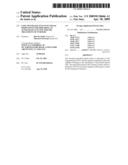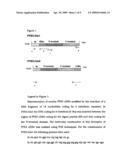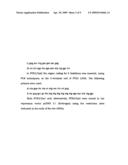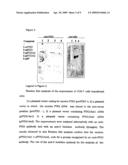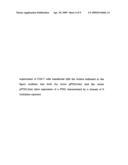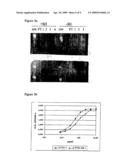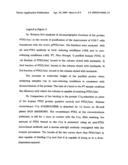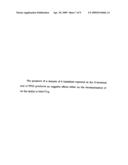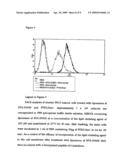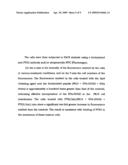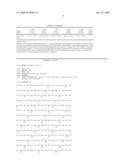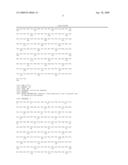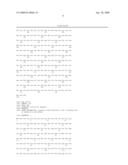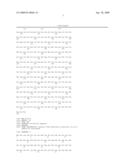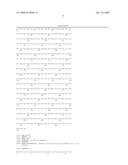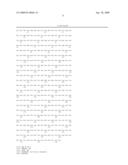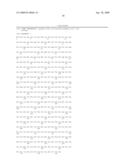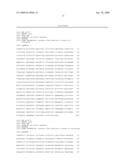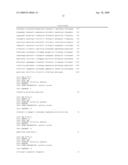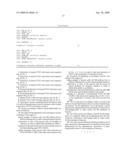Patent application title: Long pentraxin ptx3 functional derivatives for preparing an autologous vaccine for the treatment of tumours
Inventors:
Rita De Santis (Roma, IT)
Salvatori Giovanni (Roma, IT)
IPC8 Class: AA61K3512FI
USPC Class:
424 937
Class name: Drug, bio-affecting and body treating compositions whole live micro-organism, cell, or virus containing animal or plant cell
Publication date: 2009-04-30
Patent application number: 20090110666
Claims:
1. Derivative of murine PTX3 with amino-acid sequence Seq. Id. No. 1.
2. Derivative of murine PTX3 with amino-acid sequence Seq. Id. No. 2.
3. Derivative of human PTX3 with amino-acid sequence Seq. Id. No. 3.
4. Derivative of human PTX3 with amino-acid sequence Seq. Id. No. 4.
5. Biotinylated derivative of murine PTX3 with amino-acid sequence Seq. Id. No. 5.
6. Biotinylated derivative of human PTX3 with amino-acid sequence Seq. Id. No. 6.
7. Murine PTX3 CDNA having sequence Seq. Id. No. 7.
8. Murine PTX3 CDNA having sequence Seq. Id. No. 8.
9. Autologous vaccine containing inactivated tumour cells of a solid or haematological tumour, bearing on their surface a derivative of PTX3 according to claim 1.
10. Vaccine according to claim 9, which additionally contains an adjuvant.
11. Procedure for the preparation of an autologous vaccine, consisting of the stages of:taking samples of tumour cells (10-100 million) from a patient suffering from a solid or haematological tumour;inactivation, in vitro, of the tumour cells, for example, by radiation, in order to inhibit their proliferative ability;treatment of the inactivated tumour cells with liposomes of the lipid chelating agent NTA-DOGS;further treatment of the tumour cells with a derivative of PTX3 (50-500 J, G/ML) with amino-acid sequence Seq. Id. No. 1, 2, 3 or 4, in order to bind said derivative of PTX3 to the membranes of said tumour cells.
12. Procedure for preparing an autologous vaccine, consisting of the stages of:taking samples of tumour cells (10-100 million) from A patient suffering from a solid or haematological tumour;inactivation, in vitro, of the tumour cells by means of known methods, for example, radiation, in order to inhibit their ability to proliferatebiotinylation of the inactivated tumour cells with 100-1000 biotins/cell, and incubation thereof with avidin;binding of a derivative of biotinylated PTX3 (50-500, UG/ML) with amino-acid sequence Seq. Id. No. 5 or 6, to the membranes of tumour cells from the previous stage.
13. Use of a derivative according to claim 1, bound to the surface of inactivated tumour cells of a solid or haematological tumour, for the preparation of an autologous vaccine which can be administered by the subcutaneous, intravenous, intra-lymph-nodal or other routes, for the treatment of tumours.
14. Use of the vaccine according to claim 9, for the preparation of a medicine which can be administered by the subcutaneous, intravenous, intra-lymph-nodal or other routes, for the treatment of tumours.
15. Use of the vaccine obtained with the procedure according to claim 11, for the preparation of a medicine which can be administered by the subcutaneous, intravenous or intra-lymph-nodal routes, for the treatment of tumours.
Description:
[0001]The invention described herein relates to analogues of the long
pentraxin PTX3 (PTX3) and their use for the preparation of a vaccine for
the treatment of tumours.
[0002]The spontaneous activation of a response of the immune system against a tumour is often ineffective. The tumour, in fact, is capable of concealing itself from host's immune system through reduced expression of its own antigens or through the ineffective presentation of said antigens. It is known that both the class I major histocompatibility complex (MHC I) and molecules with co-stimulatory activity such as CD80 and CD86 are poorly or not all expressed by tumour cells. The tumour, moreover, is capable of secreting cytokines with an immunosuppressive activity such as IL-10 and TGFβ, the function of which is to de-energise lymphocytes activated against associated tumour antigens. On the whole, the tumour induces a state of immunological tolerance in the host. The aim of vaccine therapy for cancer is to disrupt this state of tolerance and activate an immune response against the tumour.
[0003]The methods of cancer vaccine therapy involve the use of tumour cells modified, for example, by cytokines, by co-stimulatory molecules, bacteria or toxins, for the purposes of modifying the tumour cells and making them recognisable or capable of being processed by the immune system.
[0004]PTX3 is a protein which is expressed in various cell types (Bottazzi et al., J. Biol Chem; 272: 32817-32823, 1997) particularly in mononuclear phagocytes and endothelial cells, after exposure to the inflammatory cytokines, Interleukin 1 beta (IL-1 beta) and Tumour Necrosis Factor alpha (TNF-alpha).
[0005]This protein consists of two structural domains, an N-terminal unrelated to any known molecule, and a C-terminal similar to the short pentraxins such as C-reactive protein (CRP).
[0006]The PTX3 gene is located on mouse chromosome 3, in a region similar to the human region 3q (q24-28), in agreement with the documented location of hPTX3 in the region 3q 25.
[0007]In addition, mouse PTX3 (mPTX3) (Introna M. et al., Blood 87 (1996, 1862-1872) is very similar to hPTX3 on the basis of its organisation, location and sequence (Breviario F. et al., J. Biol. Chem. 267:22190, 1992).
[0008]In particular, the degree of identity between the sequences is 82% between the human gene and the mouse gene, and as much as 92% if the conservative substitutions are considered.
[0009]The high degree of similarity between the sequence of hPTX3 and that of mPTX3 is a sign of the high degree of conservation of the pentraxins during evolution (Pepys M. B., Baltz M. L., Adv. Immunol: 34:141, 1983).
[0010]For a review of the pentraxins, see H. Gewurz et al., Current Opinion in Immunology, 1995, 7:54-64.
[0011]Previous uses of PTX3 are already known.
[0012]In WO99/32516, filed in the name of the applicant, the use of long pentraxin PTX3 is described for the therapy of diseases of an infectious, inflammatory or tumoral type. In WO99/32516 a gene therapy method is described in which the anticancer activity of PTX3 is described.
[0013]U.S. Pat. No. 5,767,252 describes a growth factor of neuronal cells belonging to the pentraxin family (see also the literature cited therein). This patent refers to the neurobiology sector.
[0014]To date the use of PTX3, or its analogues, for the preparation of a vaccine for the treatment of tumours has never been described.
[0015]It is well known in the medical field that there is a need for the availability of new vaccines for the treatment of tumours.
[0016]It has now been found that the derivatives of the long pentraxin PTX3 lend themselves to use for preparing a vaccine for the treatment of tumours.
[0017]The object of the invention described herein is therefore a derivative of murine PTX3 with amino-acid sequence Seq. Id. No. 1.
[0018]A further object of the invention described herein is a derivative of murine PTX3 with amino-acid sequence Seq. Id. No. 2.
[0019]A further object of the invention described herein is a derivative of human PTX3 with amino-acid sequence Seq. Id. No. 3.
[0020]A further object of the invention described herein is a derivative of human PTX3 with amino-acid sequence Seq. Id. No. 4.
[0021]A further object of the invention described herein is a derivative of murine PTX3 biotinylated at random, with 1-100 molecules of biotin per single protein of PTX3, with amino-acid sequence Seq. Id. No. 5.
[0022]A further object of the invention described herein is a derivative of human PTX3 biotinylated at random, with 1-100 molecules of biotin per single protein of PTX3, with amino-acid sequence Seq. Id. No. 6.
[0023]A further object of the invention described herein is a Murine PTX3 cDNA having sequence Seq. Id. No. 7.
[0024]A further object of the invention described herein is a Murine PTX3 cDNA having sequence Seq. Id. No. 8.
[0025]A further object of the invention described herein is an autologous vaccine containing inactivated tumour cells of a solid or haematological tumour, bearing on their surface a derivative of PTX3 with amino-acid sequence Seq. Id. No. 1-6, and possibly an adjuvant.
[0026]A further object of the invention described herein is a procedure for preparing an autologous vaccine, consisting of the following stages: [0027]taking tumour cells, by means of known methods, from a patient suffering from a solid or haematological tumours; [0028]inactivation, in vitro, of the tumour cells by means of known methods, e.g. radiation, in order to inhibit their proliferative ability; [0029]treatment of the inactivated tumour cells with liposomes of the lipid chelating agent NTA-DOGS, as described in the experimental part here below; [0030]further treatment of the tumour cells with a derivative of PTX3 with amino-acid sequence Seq. Id. No. 1, 2, 3 or 4, in order to bind said derivative of PTX3 to the membranes of said tumour cells, which are used for the therapeutic vaccination.
[0031]A further object of the invention described herein is a process for preparing an autologous vaccine consisting of the following stages: [0032]taking tumour cells from a patient suffering from a solid or haematological tumour; [0033]inactivation, in vitro, of the tumour cells by means of known methods, e.g. radiation, in order to inhibit their proliferative ability; [0034]biotinylation of the inactivated tumour cells and incubation of said cells with avidin, as described in the experimental part here below; [0035]binding of a derivative of biotinylated PTX3, with amino-acid sequence Seq. Id. No. 5 or 6, to the membranes of the tumour cells in the previous stage, which are used for the therapeutic vaccination.
[0036]A further object of the invention described herein is the use of a vaccine prepared with the procedures outlined above for the preparation of a medicine which can be administered, for instance, by the subcutaneous, intravenous or intra-lymph-nodal routes for the treatment of tumours.
[0037]A further object of the invention described herein is the use of a derivative of PTX3 with amino-acid sequence Seq. Id. No. 1-6, bound to the surface of the inactivated tumour cells of a solid or haematological tumour, for the preparation of an autologous vaccine which can be administered by the subcutaneous, intravenous or intra-lymph-nodal or other routes for the treatment of tumours.
[0038]A further object of the invention described herein is the use of a vaccine, prepared with a derivative of PTX3 with amino-acid sequence Seq. Id. No. 1-6, in which said derivative is bound to the surface of the inactivated tumour cells of a solid tumour, for the preparation of a medicine which can be administered by the subcutaneous, intravenous, intra-lymph-nodal or other routes for the treatment of tumours.
[0039]The tumour vaccine according to the invention described herein may contain one or more adjuvants that induce a non-specific immune response.
[0040]Examples of adjuvants are Freund's complete adjuvant, Freund's incomplete adjuvant, bacterial preparations such as, for example, BCG, preparations of bacterial components such as tuberculin, naturally-occurring macromolecular substances such as mannan yeast, alum, synthetic adjuvants such as "Titer Max Gold" and the like.
[0041]Other adjuvants can obviously also be used.
[0042]The vaccine according to the invention can be inoculated in either the presence or absence of the adjuvant.
[0043]The following examples further illustrate the invention.
[0044]Engineering of PTX3 cDNA for the Production of Recombinant Protein Containing a 6 Histidine Domain.
[0045]Murine PTX3 cDNA (Introna M. et al. Blood 87 (1996) 1862-1872) was modified by the introduction of a sequence of 18 nucleotides coding for 6 histidines between the signal peptide and the N-terminal domain of PTX3. The insertion of the 18 nucleotides in the open reading frame (ORF) of PTX3 was obtained using the recombinant PCR techniques described in Recombinant PCR (Russel Higuchi, PCR Protocols, edited by M. Innis, D. H. Gelfand, J. J. Sninsky, T. J. White, 1990, San Diego USA) (FIG. 1).
[0046]Murine PTX3 cDNA thus modified (Seq. Id. No. 7) was cloned in the plasmid expression vector pcDNA 3.1 (Invitrogen) using the EcoRI and XbaI restriction sites (Ausubel F. M. et al., 1987, Current Protocols in Molecular Biology, Wiley Interscience, New York). This plasmid vector was called pPTX3/his1.
[0047]Similar PCR techniques to those mentioned above were used to introduce the 18 nucleotides coding for 6 histidine at the C-Terminal end of murine PTX3 cDNA (FIG. 1). The murine PTX3 cDNA thus modified (Seq. Id. No. 8) was cloned in the plasmid expression vector pcDNA 3.1 (Invitrogen) using the restriction sites EcoRI e NotI. The plasmid vector was called pPTX3/his2.
[0048]Production and Purification of Derivatives PTX3/his1 and PTX3/his2
[0049]The plasmid vectors pPTX3/his1 and pPTX3/his2 were used for the transfection of COS7 cells with lipofectamine 2000 (Invitrogen) (Ciccarone et al., 1999 FOCUS 21, 54). After transfection with one of the two plasmids, these cells release an amino-acid sequence of the murine recombinant PTX3 into the culture medium (DMEM GIBCO) (the plasmid vector pPTX3/his1 codes for Seq. Id. No. 1, while plasmid vector pPTX3/his2 codes for Seq. Id. No. 2) recognised both by anti-PTX3 antibodies and by anti-histidine antibodies (Quiagen) (FIG. 2). In the transfections of COS7 cells with the plasmid pPTX3/his1, the protein produced (Seq. Id. No. 1) was called PTX3his1. Likewise, in the transfections of COS7 cells with plasmid pPTX3/his2, the protein produced (Seq. Id. No. 2) was called PTX3his2.
[0050]PTX3his1 and PTX3his2 were purified by affinity chromatography, using Amersham Pharmacia Biotech columns (Histrap Kit). The passage of the dialysed supernatant of COS-7 cells transfected with one of the two vectors and the subsequent elution of the protein with a discontinuous gradient of imidazole from these columns, permits the recovery of approximately 60-80% of the recombinant PTX3 produced.
[0051]The protein PTX3his1 shows an ability to decamerise (FIG. 3a) and bind C1q (FIG. 3b) in a similar way to that described for the naturally occurring protein of PTX3.
[0052]Likewise it is possible to prepare human recombinant PTX3 (sequences Seq. Id. Nos. 3 and 4), starting from cDNA of human PTX3 (Breviario F. et al., J. Biol. Chem. 267:22190, 1992).
[0053]Production and Purification of Naturally Occurring Murine PTX3 to be Used for Biotinylation.
[0054]Murine PTX3 cDNA (Introna M. et al., Blood 87 (1996) 1862-1872) was subcloned in the expression vector pcDNA 3.1 (Invitrogen) e subsequently transfected in COS7 cells using lipofectamine 2000 (Invitrogen) (Ciccarone et al., 1999 FOCUS 21, 54).
[0055]The recombinant protein thus obtained was purified from the culture supernatant of the COS7 cells by means of affinity chromatography, using an anti-PTX3 monoclonal antibody conjugated to protein G, with the procedure described by Bottazzi et al., J. Biol. Chem. 272(52):32817-32823, 1997.
[0056]Likewise, it is possible to prepare the human recombinant PTX3 protein starting from the expression of human cDNA in COS7 cells (Breviario F. et al., J. Biol. Chem. 267:22190, 1992).
[0057]Biotinylation of Naturally Occurring PTX3 Protein and the Membrane Proteins of Tumour Cells
[0058]Biotin is a 244-dalton molecule capable of binding avidin and streptoavidin molecules with high affinity. Biotin was bound to amino-acid residues of human and mouse PTX3, or proteins of cell membranes of inactivated tumour cells using the chemical derivative NHS-LC-Biotin (PIERCE) (Altin et al., Anal Biochem 224: 382-389, 1995). The binding of biotin molecules both to the membranes of tumour cells and to recombinant PTX3 protein makes it possible to anchor PTX3 to the tumour cell. The molecules of avidin added to the mixture of PTX3 and tumour cells act as a molecular bridge between the biotins present on the cell membrane and those bound to the PTX3 amino acids.
[0059]Modification of the P815 Tumour Cell Membrane with Liposomes of the Lipid Chelating Agent NTA-DOGS.
[0060]The lipid chelating agent NTA-DOGS (Avanti Polar Lipids Inc.) was prepared as a liposomal suspension with liposomes with a mean diameter of approximately 500 nm. As a result of the fusion of the liposomes with the cell membranes of murine P815 mastocytoma cells, NTA-DOGS is intercalated in the lipid bilayer via its hydrophobic portion and exposes, on the cell surface, the polar head of nitrolotriacetic acid capable of binding any peptide or protein containing 6 histidine domains (Broekhoven et al. 2000 J. Immunology 164: 2433-2443). The efficiency of incorporation of the lipid chelating agent in the bilayer of the membrane of the P815 tumour cell line was measured using a 6-histidine peptide conjugated to a biotin molecule. FACS (fluorescence activated cell sorter) analysis of the P815 cells treated with liposomes of NTA-DOGS (P815-NTA), with the biotinylated peptide and lastly with fluorescinated streptoavidin, revealed an approximately 100-fold increase in the fluorescent signal compared to controls (P815 treated with the biotinylated peptide alone).
[0061]The Protein PTX3/his1 is Capable of Binding to the Membrane Surface of Tumour Cells Treated with Liposomes of the Lipid Chelating Agent NTA-DOGS.
[0062]The protein PTX3/his 1 purified from the supernatant of COS-7 cells and incubated with P815-NTA cells is capable of binding to their membrane surface. FACS analysis of P815-NTA cells using anti-PTX3 antibodies revealed a 10-fold greater fluorescent signal than P815 controls not treated with the recombinant protein (FIG. 4). This result confirms that binding of PTX3/his1 to the P815 cell membrane has taken place.
EXAMPLE 1
[0063]Preparation of an Autologous Anticancer Vaccine by Means of the Use of a Derivative of PTX3 with Amino-Acid Sequence Seq. Id. No. 1, 2, 3 or 4, Bound to Tumour Cells
[0064]A) Tumour cells (10-100 million) are taken, by means of known methods, from a patient suffering from a solid tumour.
[0065]B) These tumour cells are inactivated with known methods, in vitro, in order to inhibit their proliferative ability, for example by radiation.
[0066]C) The inactivated tumour cells are treated with liposomes of the lipid chelating agent NTA-DOGS (50-250 μM).
[0067]D) The tumour cells are further treated with a derivative of PTX3 (50-500 μg/ml) with amino-acid sequence Seq. Id. No. 1, 2, 3 or 4, in order to bind said derivative of PTX3 to the membranes of said tumour cells.
[0068]E) An aliquot of tumour cells thus modified is subjected to FACS analysis to verify the presence of the PTX3 derivative on their membranes.
[0069]F) The modified tumour cells, with the PTX3 derivative bound to the membranes, are inoculated into the patient from whom they have come (autologous vaccine) by means of administration via the subcutaneous, intravenous, intra-lymph-nodal or other routes.
EXAMPLE 2
Preparation of an Autologous Anticancer Vaccine by Means of the Use of a PTX3 Derivative with Amino-Acid Sequence Seq. Id. No. 5 or 6, Bound to Tumour Cells
[0070]a) The tumour cells (10-100 million) are taken, by means of known methods, from a patient suffering from a tumour.
[0071]b) These tumour cells are inactivated, by means of known methods, in vitro, in order to inhibit their proliferative activity, for example, by radiation.
[0072]c) The inactivated tumour cells are subjected to biotinylation (100-1000 biotins/cell).
[0073]d) The biotinylated tumour cells are incubated with avidin (10-100 μg/ml).
[0074]e) To the cell membrane of the tumour cells incubated with avidin (as in para. "d") is bound a biotinylated PTX3 derivative (50-500 μg/ml) with amino-acid sequence Seq. Id. No. 5 or 6.
[0075]f) The modified tumour cells with the PTX3 bound to the membranes (as in para. "e") are inoculated into the patient from whom they have come (autologous vaccine) by means of administration via the subcutaneous, intravenous, intra-lymph-nodal or other routes.
EXAMPLE 3
[0076]The subcutaneous inoculation, in syngenic mice, of P815 cells modified ex-vivo with PTX3 on the cell membranes induces a significant reduction in the tumour growth rate.
[0077]As a model for the in-vivo study, the murine mastocytoma P815 line was used, to which the modified PTX3 was bound. The aim of the experiment was to assess the frequency of rejection or any reduction in the growth rate of the modified tumour compared to controls not treated with PTX3/his1.
[0078]Syngenic DBA2J mice were inoculated subcutaneously with 1×105 P815 cells bearing the protein PTX3/his1 on the cell membranes.
[0079]The results obtained, reported in Table 1, show that the tumour cells modified by the presence of the PTX3/his1 protein on their membranes, in DBA2J mice, grow more slowly than untreated parental cells or parental cells treated only with the lipid chelating agent NTA-DOGS.
[0080]Preliminary data obtained in further experiments show that the vaccine according to the present invention stimulates an immunogenic response against the tumour which the modified cells come from.
TABLE-US-00001 TABLE 1 13 days 15 days 17 days 20 days 22 days N. of Animal mean ± mean ± mean ± mean ± mean ± animals/ groups sd (mm3) sd (mm3) sd (mm3) sd (mm3) sd (mm3) group P815 330.2 +/- 182.5 599.5 +/- 278.7 956.8 +/- 391.4 1422.8 +/- 530.8 2325.1 +/- 1056.0 10 P815 + NTA- 355.9 +/- 222.8 420.4 +/- 362.4 626.8 +/- 434.2 851.7 +/- 590.5 967.1 +/- 519.4 9 DOGS + PTX 3his1 P815 + NTA- 379.1 +/- 207.2 628.9 +/- 291.6 1198.3 +/- 436.4 1644.7 +/- 893.6 2122.9 +/- 581.8 7 DOGS Legend to Table 1 DBA2J mice were inoculated subcutaneously with 1 × 105 murine P815 tumour cells. One group of animals (n = 7) was inoculated with P815 cells modified by treatment with liposomes of NTA-DOGS (P815 + NTA-DOGS). A second group of animals (n = 9) was inoculated with P815 cells treated with the lipid chelating agent and with PTX3/his1 (20 μg/ml) (P815 + NTA-DOGS + PTX3/his1). A third group of animals (n = 10) was treated with parental P815 cells (P815). Tumour sizes were measured in the three weeks following inoculation of the cells on the days indicated in the table, by direct measurement with a Vernier calliper. The calculation of tumour size in mm3 was done using the formula [(width2 × length)/2].
Sequence CWU
1
141387PRTArtificial Sequencesynthetic PTX3 modified at positions 18-23 by
adding six histidines 1Met His Leu Pro Ala Ile Leu Leu Cys Ala Leu
Trp Ser Ala Val Val1 5 10
15Ala His His His His His His Glu Thr Ser Asp Asp Tyr Glu Leu Met
20 25 30Tyr Val Asn Leu Asp Asn Glu
Ile Asp Asn Gly Leu His Pro Thr Glu 35 40
45Asp Pro Thr Pro Cys Asp Cys Arg Gln Glu His Ser Glu Trp Asp
Lys 50 55 60Leu Phe Ile Met Leu Glu
Asn Ser Gln Met Arg Glu Gly Met Leu Leu65 70
75 80Gln Ala Thr Asp Asp Val Leu Arg Gly Glu Leu
Gln Arg Leu Arg Ala 85 90
95Glu Leu Gly Arg Leu Ala Gly Gly Met Ala Arg Pro Cys Ala Ala Gly
100 105 110Gly Pro Ala Asp Ala Arg
Leu Val Arg Ala Leu Glu Pro Leu Leu Gln 115 120
125Glu Ser Arg Asp Ala Ser Leu Arg Leu Ala Arg Leu Glu Asp
Ala Glu 130 135 140Ala Arg Arg Pro Glu
Ala Thr Val Pro Gly Leu Gly Ala Val Leu Glu145 150
155 160Glu Leu Arg Arg Thr Arg Ala Asp Leu Ser
Ala Val Gln Ser Trp Val 165 170
175Ala Arg His Trp Leu Pro Ala Gly Cys Glu Thr Ala Ile Phe Phe Pro
180 185 190Met Arg Ser Lys Lys
Ile Phe Gly Ser Val His Pro Val Arg Pro Met 195
200 205Lys Leu Glu Ser Phe Ser Thr Cys Ile Trp Val Lys
Ala Thr Asp Val 210 215 220Leu Asn Lys
Thr Ile Leu Phe Ser Tyr Gly Thr Lys Trp Asn Pro Tyr225
230 235 240Glu Ile Gln Leu Tyr Leu Ser
Ser Gln Ser Leu Val Leu Val Val Gly 245
250 255Gly Lys Glu Asn Lys Leu Ala Ala Asp Thr Val Val
Ser Leu Gly Arg 260 265 270Trp
Ser His Leu Cys Gly Thr Trp Ser Ser Glu Gln Gly Ser Met Ser 275
280 285Leu Trp Ala Asn Gly Glu Leu Val Ala
Thr Thr Val Glu Met Ala Lys 290 295
300Ser His Ser Val Pro Glu Gly Gly Leu Leu Gln Ile Gly Gln Glu Lys305
310 315 320Asn Gly Cys Cys
Val Gly Gly Gly Phe Asp Glu Ser Leu Ala Phe Ser 325
330 335Gly Arg Ile Thr Gly Phe Asn Ile Trp Asp
Arg Val Leu Ser Glu Glu 340 345
350Glu Ile Arg Ala Ser Gly Gly Val Glu Ser Cys His Ile Arg Gly Asn
355 360 365Val Val Gly Trp Gly Val Thr
Glu Ile Gln Ala His Gly Gly Ala Gln 370 375
380Tyr Val Ser3852387PRTArtificial Sequencesynthetic PTX3 modified
at the C-terminal end by adding six histidines 2Met His Leu Pro Ala
Ile Leu Leu Cys Ala Leu Trp Ser Ala Val Val1 5
10 15Ala Glu Thr Ser Asp Asp Tyr Glu Leu Met Tyr Val
Asn Leu Asp Asn 20 25 30Glu
Ile Asp Asn Gly Leu His Pro Thr Glu Asp Pro Thr Pro Cys Asp 35
40 45Cys Arg Gln Glu His Ser Glu Trp Asp
Lys Leu Phe Ile Met Leu Glu 50 55
60Asn Ser Gln Met Arg Glu Gly Met Leu Leu Gln Ala Thr Asp Asp Val65
70 75 80Leu Arg Gly Glu Leu
Gln Arg Leu Arg Ala Glu Leu Gly Arg Leu Ala 85
90 95Gly Gly Met Ala Arg Pro Cys Ala Ala Gly Gly
Pro Ala Asp Ala Arg 100 105
110Leu Val Arg Ala Leu Glu Pro Leu Leu Gln Glu Ser Arg Asp Ala Ser
115 120 125Leu Arg Leu Ala Arg Leu Glu
Asp Ala Glu Ala Arg Arg Pro Glu Ala 130 135
140Thr Val Pro Gly Leu Gly Ala Val Leu Glu Glu Leu Arg Arg Thr
Arg145 150 155 160Ala Asp
Leu Ser Ala Val Gln Ser Trp Val Ala Arg His Trp Leu Pro
165 170 175Ala Gly Cys Glu Thr Ala Ile
Phe Phe Pro Met Arg Ser Lys Lys Ile 180 185
190Phe Gly Ser Val His Pro Val Arg Pro Met Lys Leu Glu Ser
Phe Ser 195 200 205Thr Cys Ile Trp
Val Lys Ala Thr Asp Val Leu Asn Lys Thr Ile Leu 210
215 220Phe Ser Tyr Gly Thr Lys Trp Asn Pro Tyr Glu Ile
Gln Leu Tyr Leu225 230 235
240Ser Ser Gln Ser Leu Val Leu Val Val Gly Gly Lys Glu Asn Lys Leu
245 250 255Ala Ala Asp Thr Val
Val Ser Leu Gly Arg Trp Ser His Leu Cys Gly 260
265 270Thr Trp Ser Ser Glu Gln Gly Ser Met Ser Leu Trp
Ala Asn Gly Glu 275 280 285Leu Val
Ala Thr Thr Val Glu Met Ala Lys Ser His Ser Val Pro Glu 290
295 300Gly Gly Leu Leu Gln Ile Gly Gln Glu Lys Asn
Gly Cys Cys Val Gly305 310 315
320Gly Gly Phe Asp Glu Ser Leu Ala Phe Ser Gly Arg Ile Thr Gly Phe
325 330 335Asn Ile Trp Asp
Arg Val Leu Ser Glu Glu Glu Ile Arg Ala Ser Gly 340
345 350Gly Val Glu Ser Cys His Ile Arg Gly Asn Val
Val Gly Trp Gly Val 355 360 365Thr
Glu Ile Gln Ala His Gly Gly Ala Gln Tyr Val Ser His His His 370
375 380His His His3853387PRTArtificial
Sequencesynthetic PTX3 modified at the C-terminal end by adding six
histidines 3Met His Leu Leu Ala Ile Leu Phe Cys Ala Leu Trp Ser Ala Val
Leu1 5 10 15Ala Glu Asn
Ser Asp Asp Tyr Asp Leu Met Tyr Val Asn Leu Asp Asn 20
25 30Glu Ile Asp Asn Gly Leu His Pro Thr Glu
Asp Pro Thr Pro Cys Asp 35 40
45Cys Gly Gln Glu His Ser Glu Trp Asp Lys Leu Phe Ile Met Leu Glu 50
55 60Asn Ser Gln Met Arg Glu Arg Met Leu
Leu Gln Ala Thr Asp Asp Val65 70 75
80Leu Arg Gly Glu Leu Gln Arg Leu Arg Glu Glu Leu Gly Arg
Leu Ala 85 90 95Glu Ser
Leu Ala Arg Pro Cys Ala Pro Gly Ala Pro Ala Glu Ala Arg 100
105 110Leu Thr Ser Ala Leu Asp Glu Leu Leu
Gln Ala Thr Arg Asp Ala Gly 115 120
125Arg Arg Leu Ala Arg Met Glu Gly Ala Glu Ala Gln Arg Pro Glu Glu
130 135 140Ala Gly Arg Ala Leu Ala Ala
Val Leu Glu Glu Leu Arg Gln Thr Arg145 150
155 160Ala Asp Leu His Ala Val Gln Gly Trp Ala Ala Arg
Ser Trp Leu Pro 165 170
175Ala Gly Cys Glu Thr Ala Ile Leu Phe Pro Met Arg Ser Lys Lys Ile
180 185 190Phe Gly Ser Val His Pro
Val Arg Pro Met Arg Leu Glu Ser Phe Ser 195 200
205Ala Cys Ile Trp Val Lys Ala Thr Asp Val Leu Asn Lys Thr
Ile Leu 210 215 220Phe Ser Tyr Gly Thr
Lys Arg Asn Pro Tyr Glu Ile Gln Leu Tyr Leu225 230
235 240Ser Tyr Gln Ser Ile Val Phe Val Val Gly
Gly Glu Glu Asn Lys Leu 245 250
255Val Ala Glu Ala Met Val Ser Leu Gly Arg Trp Thr His Leu Cys Gly
260 265 270Thr Trp Asn Ser Glu
Glu Gly Leu Thr Ser Leu Trp Val Asn Gly Glu 275
280 285Leu Ala Ala Thr Thr Val Glu Met Ala Thr Gly His
Ile Val Pro Glu 290 295 300Gly Gly Ile
Leu Gln Ile Gly Gln Glu Lys Asn Gly Cys Cys Val Gly305
310 315 320Gly Gly Phe Asp Glu Thr Leu
Ala Phe Ser Gly Arg Leu Thr Gly Phe 325
330 335Asn Ile Trp Asp Ser Val Leu Ser Asn Glu Glu Ile
Arg Glu Thr Gly 340 345 350Gly
Ala Glu Ser Cys His Ile Arg Gly Asn Ile Val Gly Trp Gly Val 355
360 365Thr Glu Ile Gln Pro His Gly Gly Ala
Gln Tyr Val Ser His His His 370 375
380His His His3854387PRTArtificial Sequencesynthetic PTX3 modified at
positions 18-23 by adding six histidines 4Met His Leu Leu Ala Ile
Leu Phe Cys Ala Leu Trp Ser Ala Val Leu1 5
10 15Ala His His His His His His Glu Asn Ser Asp Asp Tyr
Asp Leu Met 20 25 30Tyr Val
Asn Leu Asp Asn Glu Ile Asp Asn Gly Leu His Pro Thr Glu 35
40 45Asp Pro Thr Pro Cys Asp Cys Gly Gln Glu
His Ser Glu Trp Asp Lys 50 55 60Leu
Phe Ile Met Leu Glu Asn Ser Gln Met Arg Glu Arg Met Leu Leu65
70 75 80Gln Ala Thr Asp Asp Val
Leu Arg Gly Glu Leu Gln Arg Leu Arg Glu 85
90 95Glu Leu Gly Arg Leu Ala Glu Ser Leu Ala Arg Pro
Cys Ala Pro Gly 100 105 110Ala
Pro Ala Glu Ala Arg Leu Thr Ser Ala Leu Asp Glu Leu Leu Gln 115
120 125Ala Thr Arg Asp Ala Gly Arg Arg Leu
Ala Arg Met Glu Gly Ala Glu 130 135
140Ala Gln Arg Pro Glu Glu Ala Gly Arg Ala Leu Ala Ala Val Leu Glu145
150 155 160Glu Leu Arg Gln
Thr Arg Ala Asp Leu His Ala Val Gln Gly Trp Ala 165
170 175Ala Arg Ser Trp Leu Pro Ala Gly Cys Glu
Thr Ala Ile Leu Phe Pro 180 185
190Met Arg Ser Lys Lys Ile Phe Gly Ser Val His Pro Val Arg Pro Met
195 200 205Arg Leu Glu Ser Phe Ser Ala
Cys Ile Trp Val Lys Ala Thr Asp Val 210 215
220Leu Asn Lys Thr Ile Leu Phe Ser Tyr Gly Thr Lys Arg Asn Pro
Tyr225 230 235 240Glu Ile
Gln Leu Tyr Leu Ser Tyr Gln Ser Ile Val Phe Val Val Gly
245 250 255Gly Glu Glu Asn Lys Leu Val
Ala Glu Ala Met Val Ser Leu Gly Arg 260 265
270Trp Thr His Leu Cys Gly Thr Trp Asn Ser Glu Glu Gly Leu
Thr Ser 275 280 285Leu Trp Val Asn
Gly Glu Leu Ala Ala Thr Thr Val Glu Met Ala Thr 290
295 300Gly His Ile Val Pro Glu Gly Gly Ile Leu Gln Ile
Gly Gln Glu Lys305 310 315
320Asn Gly Cys Cys Val Gly Gly Gly Phe Asp Glu Thr Leu Ala Phe Ser
325 330 335Gly Arg Leu Thr Gly
Phe Asn Ile Trp Asp Ser Val Leu Ser Asn Glu 340
345 350Glu Ile Arg Glu Thr Gly Gly Ala Glu Ser Cys His
Ile Arg Gly Asn 355 360 365Ile Val
Gly Trp Gly Val Thr Glu Ile Gln Pro His Gly Gly Ala Gln 370
375 380Tyr Val Ser3855381PRTArtificial
Sequencesynthetic PTX3 biotinylated randomly with 1-100 biotins 5Met
His Leu Pro Ala Ile Leu Leu Cys Ala Leu Trp Ser Ala Val Val1
5 10 15Ala Glu Thr Ser Asp Asp Tyr Glu
Leu Met Tyr Val Asn Leu Asp Asn 20 25
30Glu Ile Asp Asn Gly Leu His Pro Thr Glu Asp Pro Thr Pro Cys
Asp 35 40 45Cys Arg Gln Glu His
Ser Glu Trp Asp Lys Leu Phe Ile Met Leu Glu 50 55
60Asn Ser Gln Met Arg Glu Gly Met Leu Leu Gln Ala Thr Asp
Asp Val65 70 75 80Leu
Arg Gly Glu Leu Gln Arg Leu Arg Ala Glu Leu Gly Arg Leu Ala
85 90 95Gly Gly Met Ala Arg Pro Cys
Ala Ala Gly Gly Pro Ala Asp Ala Arg 100 105
110Leu Val Arg Ala Leu Glu Pro Leu Leu Gln Glu Ser Arg Asp
Ala Ser 115 120 125Leu Arg Leu Ala
Arg Leu Glu Asp Ala Glu Ala Arg Arg Pro Glu Ala 130
135 140Thr Val Pro Gly Leu Gly Ala Val Leu Glu Glu Leu
Arg Arg Thr Arg145 150 155
160Ala Asp Leu Ser Ala Val Gln Ser Trp Val Ala Arg His Trp Leu Pro
165 170 175Ala Gly Cys Glu Thr
Ala Ile Phe Phe Pro Met Arg Ser Lys Lys Ile 180
185 190Phe Gly Ser Val His Pro Val Arg Pro Met Lys Leu
Glu Ser Phe Ser 195 200 205Thr Cys
Ile Trp Val Lys Ala Thr Asp Val Leu Asn Lys Thr Ile Leu 210
215 220Phe Ser Tyr Gly Thr Lys Trp Asn Pro Tyr Glu
Ile Gln Leu Tyr Leu225 230 235
240Ser Ser Gln Ser Leu Val Leu Val Val Gly Gly Lys Glu Asn Lys Leu
245 250 255Ala Ala Asp Thr
Val Val Ser Leu Gly Arg Trp Ser His Leu Cys Gly 260
265 270Thr Trp Ser Ser Glu Gln Gly Ser Met Ser Leu
Trp Ala Asn Gly Glu 275 280 285Leu
Val Ala Thr Thr Val Glu Met Ala Lys Ser His Ser Val Pro Glu 290
295 300Gly Gly Leu Leu Gln Ile Gly Gln Glu Lys
Asn Gly Cys Cys Val Gly305 310 315
320Gly Gly Phe Asp Glu Ser Leu Ala Phe Ser Gly Arg Ile Thr Gly
Phe 325 330 335Asn Ile Trp
Asp Arg Val Leu Ser Glu Glu Glu Ile Arg Ala Ser Gly 340
345 350Gly Val Glu Ser Cys His Ile Arg Gly Asn
Val Val Gly Trp Gly Val 355 360
365Thr Glu Ile Gln Ala His Gly Gly Ala Gln Tyr Val Ser 370
375 3806381PRTArtificial Sequencesynthetic PTX3
biotinylated randomly with 1-100 biotins 6Met His Leu Leu Ala Ile
Leu Phe Cys Ala Leu Trp Ser Ala Val Leu1 5
10 15Ala Glu Asn Ser Asp Asp Tyr Asp Leu Met Tyr Val Asn
Leu Asp Asn 20 25 30Glu Ile
Asp Asn Gly Leu His Pro Thr Glu Asp Pro Thr Pro Cys Asp 35
40 45Cys Gly Gln Glu His Ser Glu Trp Asp Lys
Leu Phe Ile Met Leu Glu 50 55 60Asn
Ser Gln Met Arg Glu Arg Met Leu Leu Gln Ala Thr Asp Asp Val65
70 75 80Leu Arg Gly Glu Leu Gln
Arg Leu Arg Glu Glu Leu Gly Arg Leu Ala 85
90 95Glu Ser Leu Ala Arg Pro Cys Ala Pro Gly Ala Pro
Ala Glu Ala Arg 100 105 110Leu
Thr Ser Ala Leu Asp Glu Leu Leu Gln Ala Thr Arg Asp Ala Gly 115
120 125Arg Arg Leu Ala Arg Met Glu Gly Ala
Glu Ala Gln Arg Pro Glu Glu 130 135
140Ala Gly Arg Ala Leu Ala Ala Val Leu Glu Glu Leu Arg Gln Thr Arg145
150 155 160Ala Asp Leu His
Ala Val Gln Gly Trp Ala Ala Arg Ser Trp Leu Pro 165
170 175Ala Gly Cys Glu Thr Ala Ile Leu Phe Pro
Met Arg Ser Lys Lys Ile 180 185
190Phe Gly Ser Val His Pro Val Arg Pro Met Arg Leu Glu Ser Phe Ser
195 200 205Ala Cys Ile Trp Val Lys Ala
Thr Asp Val Leu Asn Lys Thr Ile Leu 210 215
220Phe Ser Tyr Gly Thr Lys Arg Asn Pro Tyr Glu Ile Gln Leu Tyr
Leu225 230 235 240Ser Tyr
Gln Ser Ile Val Phe Val Val Gly Gly Glu Glu Asn Lys Leu
245 250 255Val Ala Glu Ala Met Val Ser
Leu Gly Arg Trp Thr His Leu Cys Gly 260 265
270Thr Trp Asn Ser Glu Glu Gly Leu Thr Ser Leu Trp Val Asn
Gly Glu 275 280 285Leu Ala Ala Thr
Thr Val Glu Met Ala Thr Gly His Ile Val Pro Glu 290
295 300Gly Gly Ile Leu Gln Ile Gly Gln Glu Lys Asn Gly
Cys Cys Val Gly305 310 315
320Gly Gly Phe Asp Glu Thr Leu Ala Phe Ser Gly Arg Leu Thr Gly Phe
325 330 335Asn Ile Trp Asp Ser
Val Leu Ser Asn Glu Glu Ile Arg Glu Thr Gly 340
345 350Gly Ala Glu Ser Cys His Ile Arg Gly Asn Ile Val
Gly Trp Gly Val 355 360 365Thr Glu
Ile Gln Pro His Gly Gly Ala Gln Tyr Val Ser 370 375
38071244DNAArtificial Sequencesynthetic PTX3 modified to
encode six histidines 7ctaggattcg gatcactgta gagtctcgct tcttcccctg
cggctgcgaa cgaaatttcg 60cctctccagc aatgcacctc cctgcgatcc tgctttgtgc
tctctggtct gcagtagtgg 120ctcatcacca tcaccatcat gagacctcgg atgactacga
gctcatgtat gtgaatttgg 180acaacgaaat agacaatgga cttcatccca ccgaggaccc
cacgccatgc gactgccgcc 240aggagcactc ggagtgggac aagctgttca tcatgctgga
gaactcgcag atgcgggagg 300gcatgctgtt gcaggccacc gacgacgtcc tccgtggaga
gctgcagcgg ctgcgggcag 360agctggggcg gctggcgggc ggcatggcga ggccgtgcgc
agccggtggc cccgcagacg 420ccaggctggt gcgggcgctg gagccgctgc tgcaggagag
ccgtgacgcg agcctcaggc 480tggcgcgcct ggaggacgcg gaggcgcggc gacccgaggc
gacagtgcct ggcctaggcg 540ctgtgctgga ggaactgcgg cggacgcgcg ccgacctgag
cgccgtgcag agctgggtcg 600cccgccactg gctgcccgca ggttgtgaaa cagcaatttt
cttcccaatg cgttcgaaga 660agatttttgg aagcgtgcat cctgtgagac caatgaagct
tgaatctttt agtacttgca 720tttgggtcaa agccacagat gtattaaaca aaaccatcct
gttttcttat ggcacaaagt 780ggaaccccta tgagattcag ctgtacctca gttcccagtc
cctagtgttg gtggtgggtg 840gaaaggagaa caagctggct gcagacactg tggtgtccct
ggggaggtgg tcccacctgt 900gtggcacctg gagttcagag caggggagca tgtccctgtg
ggcaaacggg gagctggtgg 960ctaccactgt agagatggcc aaaagtcact ctgttcctga
gggtggactc ctacagattg 1020gccaagaaaa gaatggttgc tgtgtaggtg ggggctttga
cgaatcatta gcattttctg 1080gaagaatcac aggcttcaat atctgggatc gggttctcag
cgaggaggag atacgggcca 1140gtggaggagt cgaatcctgt cacatccggg gaaatgtcgt
cgggtgggga gtcacagaga 1200ttcaggcgca cggaggagcc cagtatgttt cttaatctag
agag 124481189DNAArtificial Sequencesynthetic PTX3
modified to encode six histidines 8ctagaattcc taccatgcac ctccctgcga
tcctgctttg tgctctctgg tctgcagtag 60tggctgagac ctcggatgac tacgagctca
tgtatgtgaa tttggacaac gaaatagaca 120atggacttca tcccaccgag gaccccacgc
catgcgactg ccgccaggag cactcggagt 180gggacaagct gttcatcatg ctggagaact
cgcagatgcg ggagggcatg ctgttgcagg 240ccaccgacga cgtcctccgt ggagagctgc
agcggctgcg ggcagagctg gggcggctgg 300cgggcggcat ggcgaggccg tgcgcagccg
gtggccccgc agacgccagg ctggtgcggg 360cgctggagcc gctgctgcag gagagccgtg
acgcgagcct caggctggcg cgcctggagg 420acgcggaggc gcggcgaccc gaggcgacag
tgcctggcct aggcgctgtg ctggaggaac 480tgcggcggac gcgcgccgac ctgagcgccg
tgcagagctg ggtcgcccgc cactggctgc 540ccgcaggttg tgaaacagca attttcttcc
caatgcgttc gaagaagatt tttggaagcg 600tgcatcctgt gagaccaatg aagcttgaat
cttttagtac ttgcatttgg gtcaaagcca 660cagatgtatt aaacaaaacc atcctgtttt
cttatggcac aaagtggaac ccctatgaga 720ttcagctgta cctcagttcc cagtccctag
tgttggtggt gggtggaaag gagaacaagc 780tggctgcaga cactgtggtg tccctgggga
ggtggtccca cctgtgtggc acctggagtt 840cagagcaggg gagcatgtcc ctgtgggcaa
acggggagct ggtggctacc actgtagaga 900tggccaaaag tcactctgtt cctgagggtg
gactcctaca gattggccaa gaaaagaatg 960gttgctgtgt aggtgggggc tttgacgaat
cattagcatt ttctggaaga atcacaggct 1020tcaatatctg ggatcgggtt ctcagcgagg
aggagatacg ggccagtgga ggagtcgaat 1080cctgtcacat ccggggaaat gtcgtcgggt
ggggagtcac agagattcag gcgcacggag 1140gagcccagta tgtttctcat catcatcatc
atcattaagc ggccgcgag 1189929DNAArtificial Sequencesynthetic
primer 9ctagaattcg gatcactgta gagtctcgc
291054DNAArtificial Sequencesynthetic primer 10ctcgtagtca tccgaggtct
catgatggtg atggtgatga gccactactg caga 541121DNAArtificial
Sequencesynthetic primer 11gagacctcgg atgactacga g
211230DNAArtificial Sequencesynthetic primer
12ctctctagat taagaaacat actgggctcc
301329DNAArtificial Sequencesynthetic primer 13ctagaattcc taccatgcac
ctccctgcg 291447DNAArtificial
Sequencesynthetic primer 14ctcgcggccg cttaatgatg atgatgatga tgagaaacat
actgggc 47
User Contributions:
Comment about this patent or add new information about this topic:

